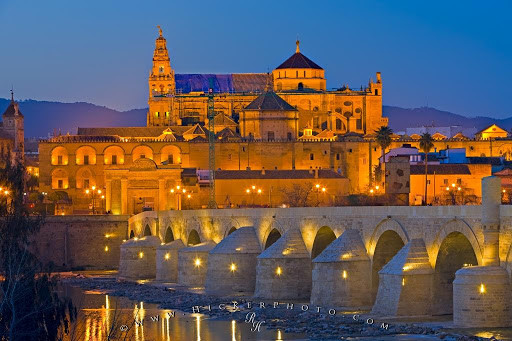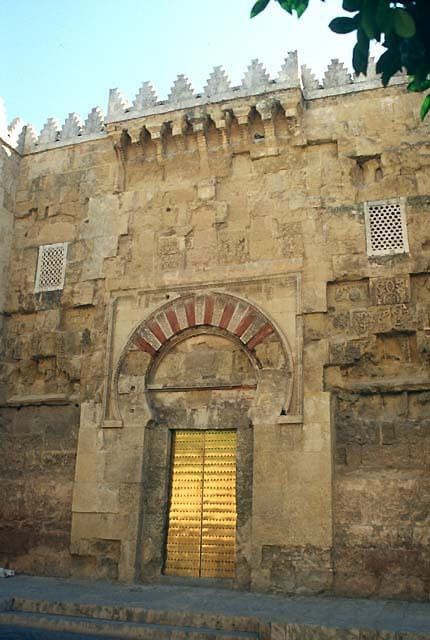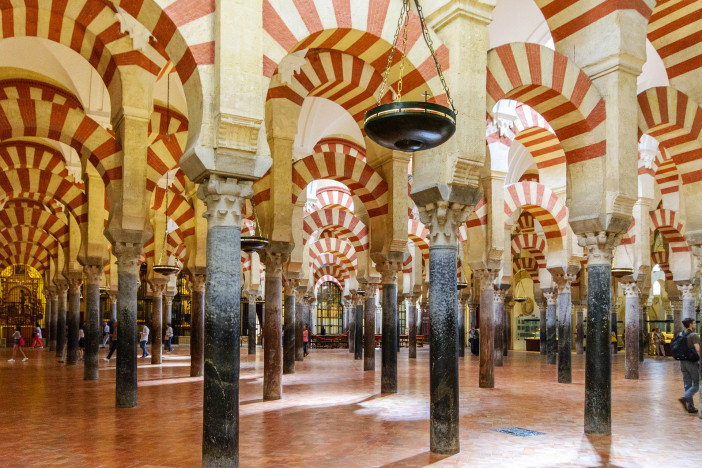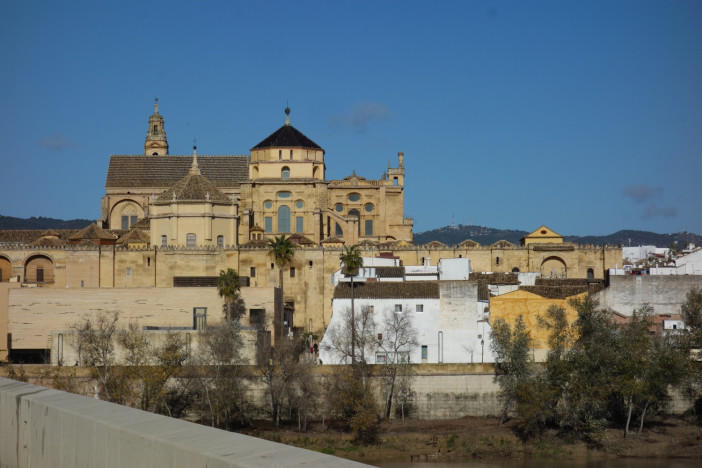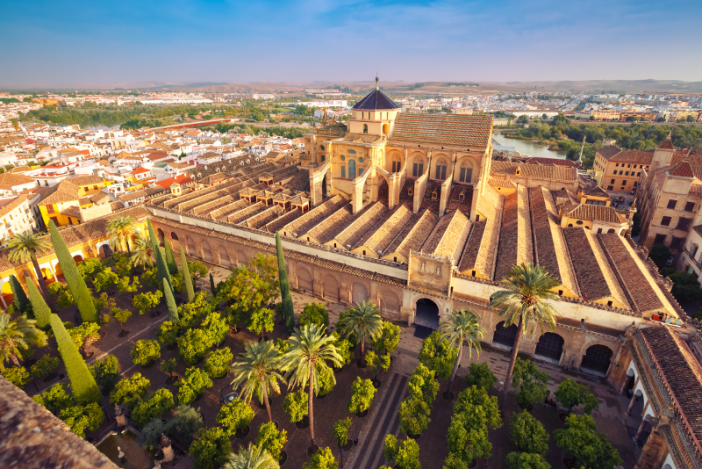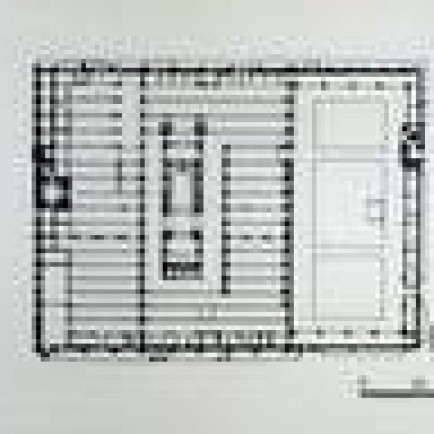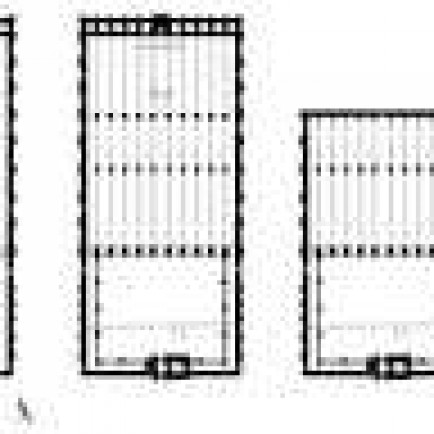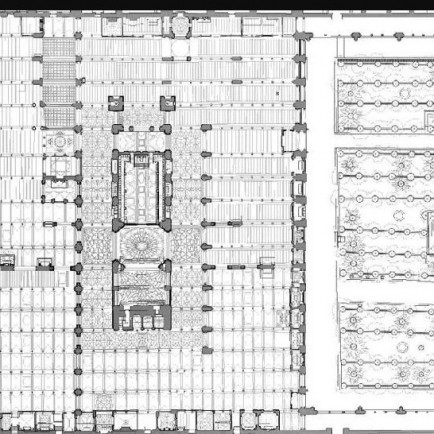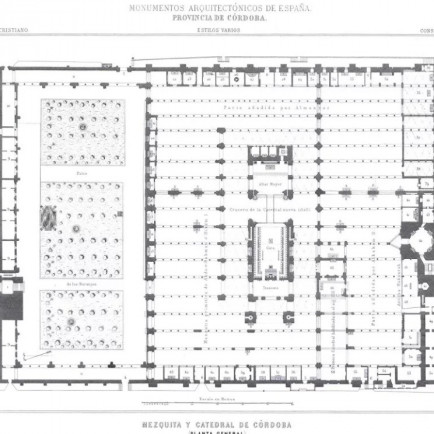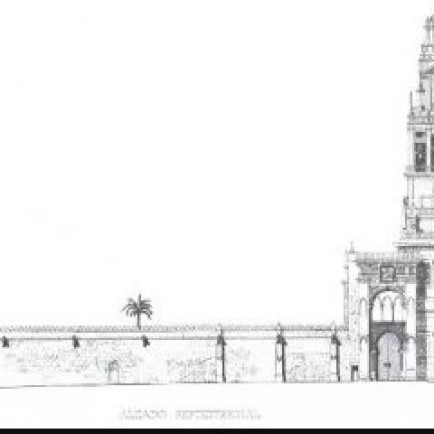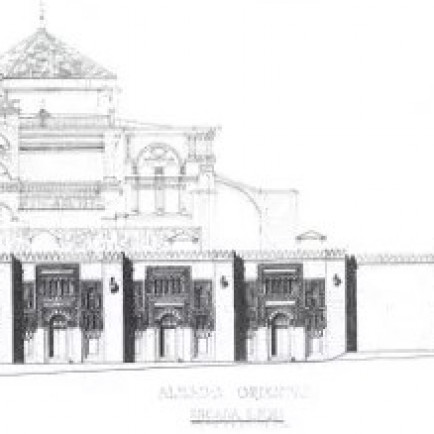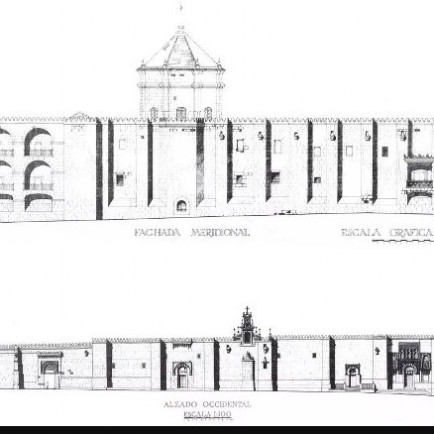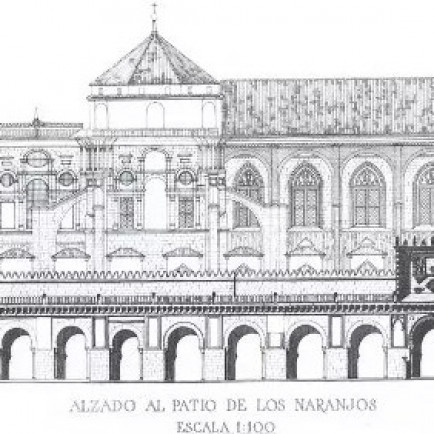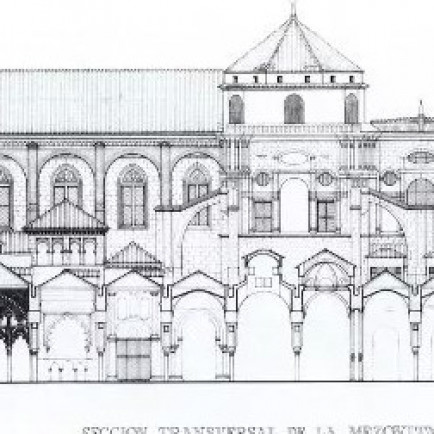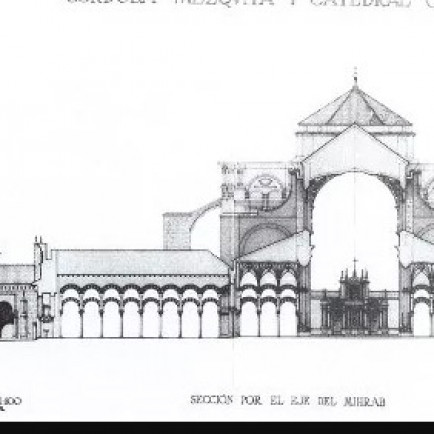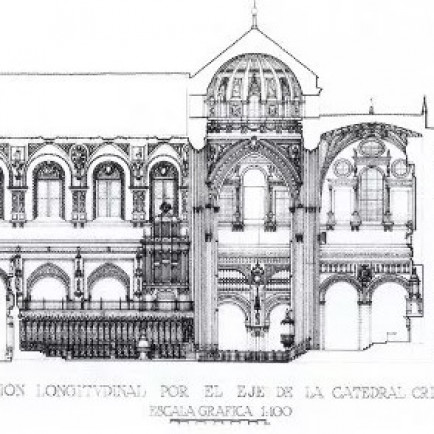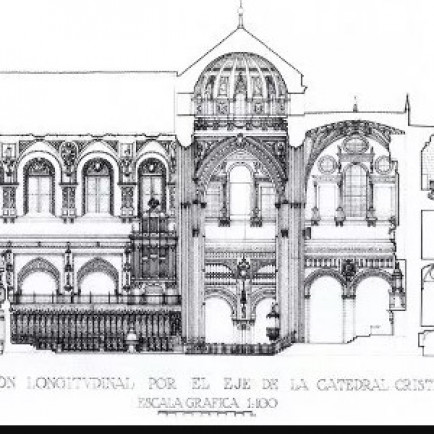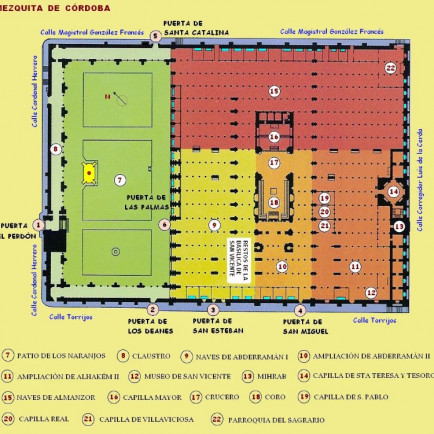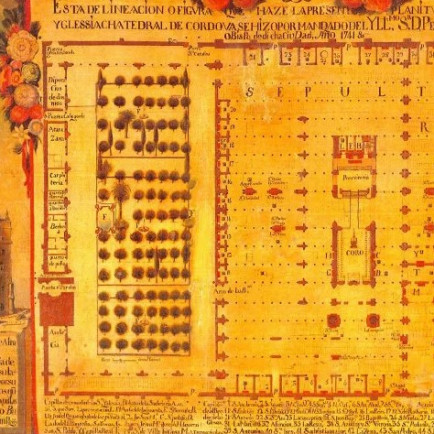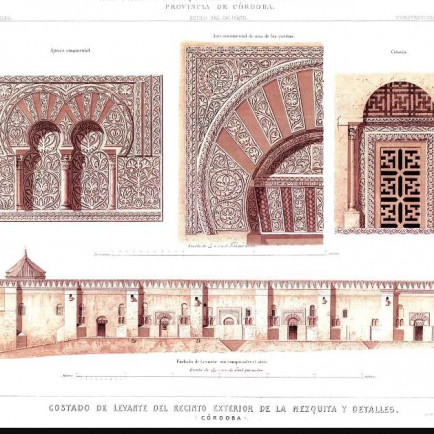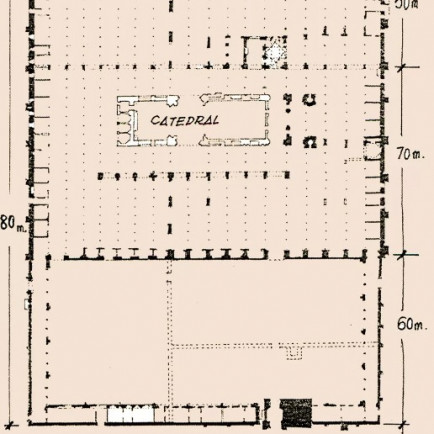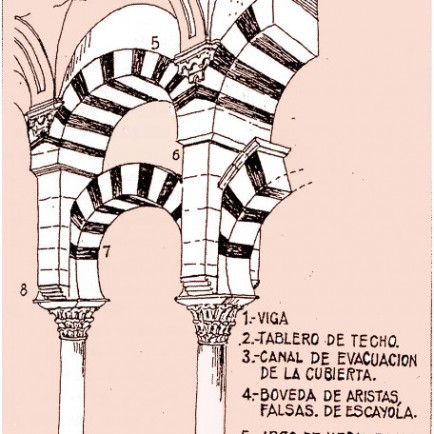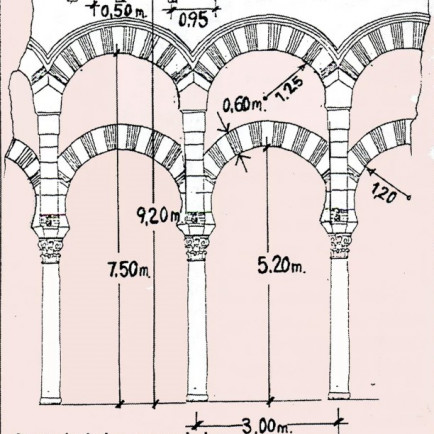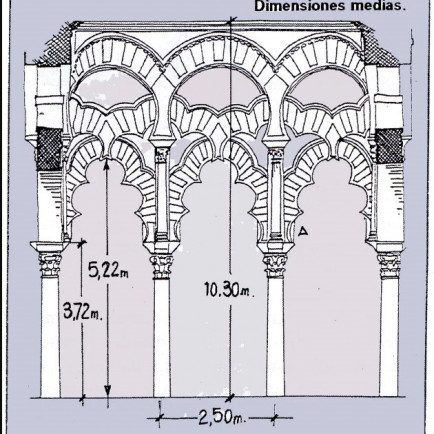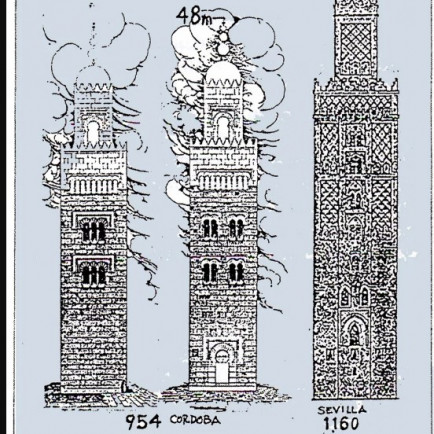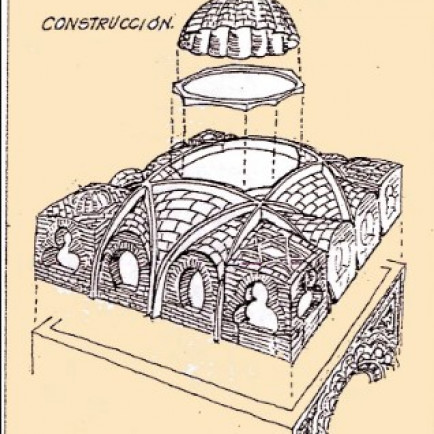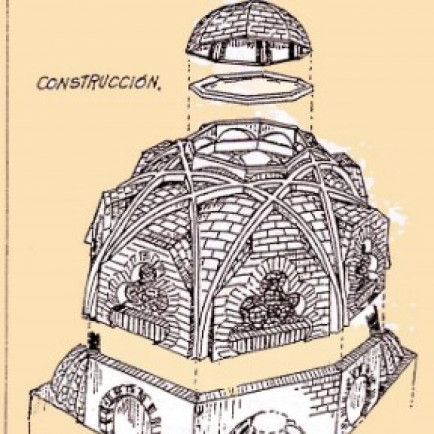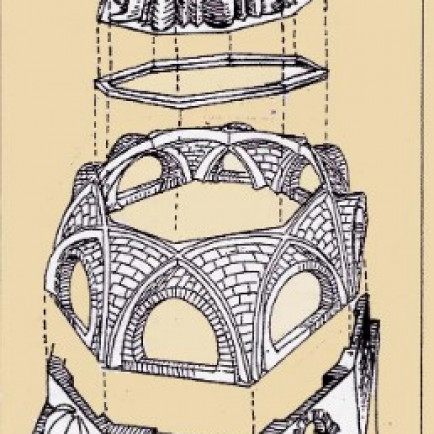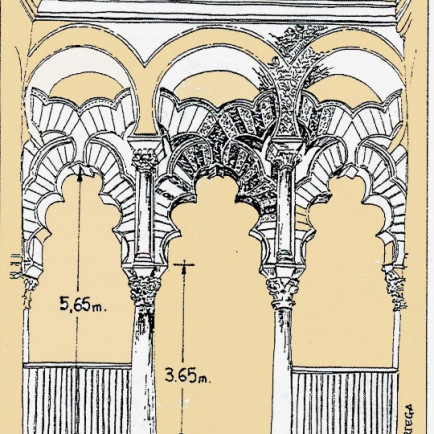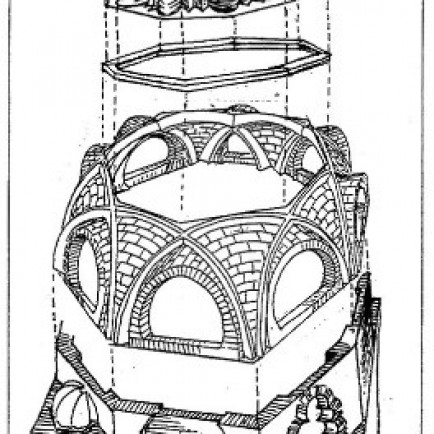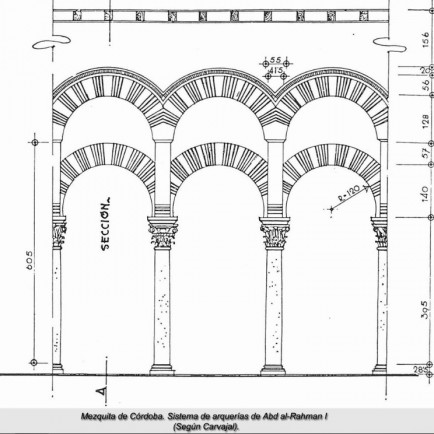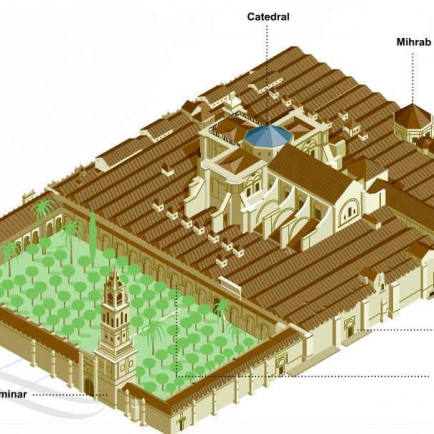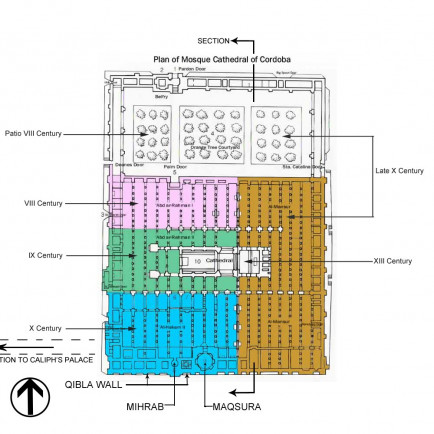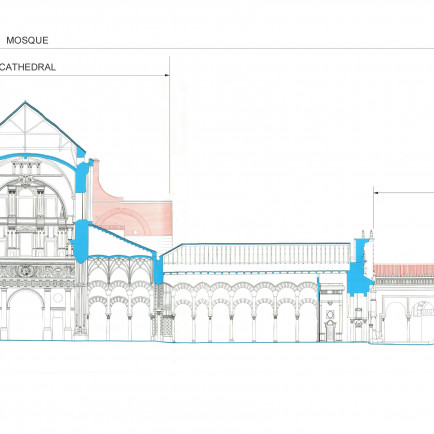Mezquita de Córdoba
History
The Great Mosque of Cordoba was considered a wonder of the medieval world by both Muslims and Christians. Built on a Visigothic site, which was probably the site of an earlier Roman temple, the Great Mosque of Cordoba was begun between 784 and 786 during the reign of 'Abd al-Rahman I, who escaped from Syria to the Iberian Peninsula after his family was massacred by a rival political dynasty.
Though the mosque was expanded by later rulers (the most significant changes dating from the reigns of 'Abd al-Rahman II between 833-852, al-Hakam II between 961-976, and the vizier al-Mansur from 987), the basic formula of arcades with alternating voussoirs was maintained in each of the additions. The resulting vistas of columns and arcades that stretch into the dim recesses of the prayer hall create a mysterious space that is often described as a forest of stone. The comparison is heightened by rows of trees planted in the courtyard (Patio de las Naranjas or Court of the Oranges), which create a visual continuation of the rows of columns within the prayer hall.
After conquering Cordoba in 1236, Ferdinand III king of Castile consecrated the Great Mosque as the city's cathedral. The Christian population of Cordoba used the former mosque with relatively minor changes for the next three hundred years. In the early 16th century the Bishop and Canons of the cathedral proposed the construction of a new cathedral, and proposed to demolish the mosque in order to build it. The opposition of the townspeople to the proposed destruction of the building led to the unprecedented decision, endorsed by the Holy Roman Emperor Charles V, to insert an entire Gothic "chapel" into the very heart of the former Great Mosque. The result is an uneasy and controversial juxtaposition: the soaring forms of a Gothic cathedral rise from the very centre of the comparatively low, sprawling prayer hall whose architectural vocabulary is rooted in the forms of classical antiquity.
Urban and Architectural
The most lavish interior ornament is concentrated in the maqsura, the prayer space reserved for the ruler, which was commissioned by the caliph al-Hakam II. The maqsura is visually separated from the rest of the prayer hall by screens formed of elaborate intersecting polylobed arcades, an elegant variation on the basic architectural theme set in the earliest incarnation of the mosque. These screens emphasise the special status of the space, which is composed of three domed bays in front of the mihrab. The mihrab was unprecedented for taking the form of an entire room rather than the traditional niche, and for being flanked by two rooms whose entrances are decorated with mosaics in a manner similar to that of the mihrab. The maqsura is lavishly decorated with carved marble, stucco, and elaborate mosaics. These, executed in intricate vegetal scroll forms and Kufic inscriptions, frame the mihrab, the mihrab was unprecedented for taking the form of an entire room rather than the traditional niche, and for being flanked by two rooms whose entrances are decorated with mosaics in a manner similar to that of the mihrab. The maqsura is lavishly decorated with carved marble, stucco, and elaborate mosaics. These, executed in intricate vegetal scroll forms and Kufic inscriptions, frame the mihrab, the two doors which flank it, and also cover the interiors of the maqsura's three domes. The unusual arrangement of the maqsura space may be read on several levels. It may reflect the appropriation of a tri-apsidal arrangement found in local church architecture (though emptied in its new context of Christian connotations). It has also been interpreted as an ideologically charged iconographic evocation of the Mosque of the Prophet in Medina that served to underscore notions of Umayyad religious and political authority.
Description
The Mosque–Cathedral of Córdoba (Spanish: Mezquita-Catedral de Córdoba; Arabic: كاتدرائية - جامع قرطبة), officially known by its ecclesiastical name, the Cathedral of Our Lady of the Assumption is the cathedral of the Roman Catholic Diocese of Córdoba dedicated to the Assumption of Mary and located in the Spanish region of Andalusia. Due to its status as a former Islamic place of worship, it is also known as the Great Mosque of Córdoba (Spanish: Mezquita de Córdoba),or the Mezquita.The structure is regarded as one of the most accomplished monuments of Moorish architecture built by the European Moors.
References
https://en.wikipedia.org/wiki/Mosque%E2%80%93Cathedral_of_C%C3%B3rdoba
Details
Location
C. Cardenal Herrero, 1, 14003 Córdoba
Year of Build
784
Area
23,400 square meters
Drawings
Map
History
The Great Mosque of Cordoba was considered a wonder of the medieval world by both Muslims and Christians. Built on a Visigothic site, which was probably the site of an earlier Roman temple, the Great Mosque of Cordoba was begun between 784 and 786 during the reign of 'Abd al-Rahman I, who escaped from Syria to the Iberian Peninsula after his family was massacred by a rival political dynasty.
Though the mosque was expanded by later rulers (the most significant changes dating from the reigns of 'Abd al-Rahman II between 833-852, al-Hakam II between 961-976, and the vizier al-Mansur from 987), the basic formula of arcades with alternating voussoirs was maintained in each of the additions. The resulting vistas of columns and arcades that stretch into the dim recesses of the prayer hall create a mysterious space that is often described as a forest of stone. The comparison is heightened by rows of trees planted in the courtyard (Patio de las Naranjas or Court of the Oranges), which create a visual continuation of the rows of columns within the prayer hall.
After conquering Cordoba in 1236, Ferdinand III king of Castile consecrated the Great Mosque as the city's cathedral. The Christian population of Cordoba used the former mosque with relatively minor changes for the next three hundred years. In the early 16th century the Bishop and Canons of the cathedral proposed the construction of a new cathedral, and proposed to demolish the mosque in order to build it. The opposition of the townspeople to the proposed destruction of the building led to the unprecedented decision, endorsed by the Holy Roman Emperor Charles V, to insert an entire Gothic "chapel" into the very heart of the former Great Mosque. The result is an uneasy and controversial juxtaposition: the soaring forms of a Gothic cathedral rise from the very centre of the comparatively low, sprawling prayer hall whose architectural vocabulary is rooted in the forms of classical antiquity.
Urban and Architectural
The most lavish interior ornament is concentrated in the maqsura, the prayer space reserved for the ruler, which was commissioned by the caliph al-Hakam II. The maqsura is visually separated from the rest of the prayer hall by screens formed of elaborate intersecting polylobed arcades, an elegant variation on the basic architectural theme set in the earliest incarnation of the mosque. These screens emphasise the special status of the space, which is composed of three domed bays in front of the mihrab. The mihrab was unprecedented for taking the form of an entire room rather than the traditional niche, and for being flanked by two rooms whose entrances are decorated with mosaics in a manner similar to that of the mihrab. The maqsura is lavishly decorated with carved marble, stucco, and elaborate mosaics. These, executed in intricate vegetal scroll forms and Kufic inscriptions, frame the mihrab, the mihrab was unprecedented for taking the form of an entire room rather than the traditional niche, and for being flanked by two rooms whose entrances are decorated with mosaics in a manner similar to that of the mihrab. The maqsura is lavishly decorated with carved marble, stucco, and elaborate mosaics. These, executed in intricate vegetal scroll forms and Kufic inscriptions, frame the mihrab, the two doors which flank it, and also cover the interiors of the maqsura's three domes. The unusual arrangement of the maqsura space may be read on several levels. It may reflect the appropriation of a tri-apsidal arrangement found in local church architecture (though emptied in its new context of Christian connotations). It has also been interpreted as an ideologically charged iconographic evocation of the Mosque of the Prophet in Medina that served to underscore notions of Umayyad religious and political authority.
Description
The Mosque–Cathedral of Córdoba (Spanish: Mezquita-Catedral de Córdoba; Arabic: كاتدرائية - جامع قرطبة), officially known by its ecclesiastical name, the Cathedral of Our Lady of the Assumption is the cathedral of the Roman Catholic Diocese of Córdoba dedicated to the Assumption of Mary and located in the Spanish region of Andalusia. Due to its status as a former Islamic place of worship, it is also known as the Great Mosque of Córdoba (Spanish: Mezquita de Córdoba),or the Mezquita.The structure is regarded as one of the most accomplished monuments of Moorish architecture built by the European Moors.


